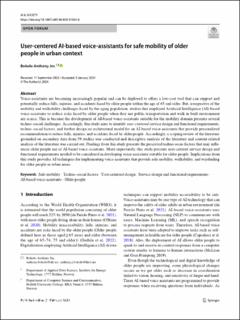| dc.contributor.author | Bokolo, Anthony Junior | |
| dc.date.accessioned | 2024-02-26T13:02:14Z | |
| dc.date.available | 2024-02-26T13:02:14Z | |
| dc.date.created | 2024-02-21T11:30:09Z | |
| dc.date.issued | 2024 | |
| dc.identifier.citation | AI & Society. 2024. | en_US |
| dc.identifier.issn | 0951-5666 | |
| dc.identifier.uri | https://hdl.handle.net/11250/3119932 | |
| dc.description.abstract | Voice-assistants are becoming increasingly popular and can be deployed to ofers a low-cost tool that can support and potentially reduce falls, injuries, and accidents faced by older people within the age of 65 and older. But, irrespective of the mobility and walkability challenges faced by the aging population, studies that employed Artifcial Intelligence (AI)-based voice-assistants to reduce risks faced by older people when they use public transportation and walk in built environment are scarce. This is because the development of AI-based voice-assistants suitable for the mobility domain presents several techno–social challenges. Accordingly, this study aims to identify user-centered service design and functional requirements, techno–social factors, and further design an architectural model for an AI-based voice-assistants that provide personalized recommendation to reduce falls, injuries, and accidents faced by older people. Accordingly, a scoping review of the literature grounded on secondary data from 59 studies was conducted and descriptive analysis of the literature and content-related analysis of the literature was carried out. Findings from this study presents the perceived techno-socio factors that may infuences older people use of AI-based voice-assistants. More importantly, this study presents user-centred service design and functional requirements needed to be considered in developing voice-assistants suitable for older people. Implications from this study provides AI techniques for implementing voice-assistants that provide safe mobility, walkability, and wayfnding for older people in urban areas. | en_US |
| dc.language.iso | eng | en_US |
| dc.publisher | Springer | en_US |
| dc.rights | Navngivelse 4.0 Internasjonal | * |
| dc.rights.uri | http://creativecommons.org/licenses/by/4.0/deed.no | * |
| dc.subject | safe mobility | en_US |
| dc.subject | techno–social factors | en_US |
| dc.subject | user-centered design | en_US |
| dc.subject | service design and functional requirements | en_US |
| dc.subject | AI-based voice-assistants | en_US |
| dc.subject | older people | en_US |
| dc.title | User‑centered AI‑based voice‑assistants for safe mobility of older people in urban context | en_US |
| dc.type | Peer reviewed | en_US |
| dc.type | Journal article | en_US |
| dc.description.version | publishedVersion | en_US |
| dc.rights.holder | © The Author(s) 2024 | en_US |
| dc.subject.nsi | VDP::Teknologi: 500::Informasjons- og kommunikasjonsteknologi: 550 | en_US |
| dc.source.journal | AI & Society | en_US |
| dc.identifier.doi | 10.1007/s00146-024-01865-8 | |
| dc.identifier.cristin | 2248383 | |
| cristin.ispublished | true | |
| cristin.fulltext | original | |
| cristin.qualitycode | 1 | |

